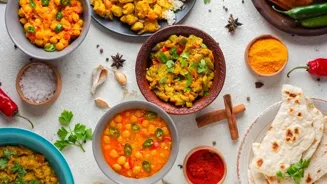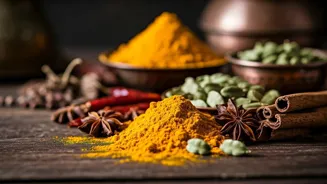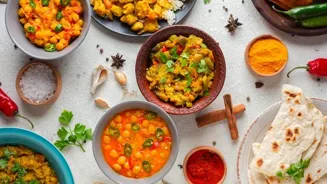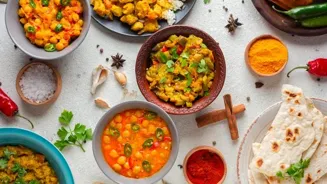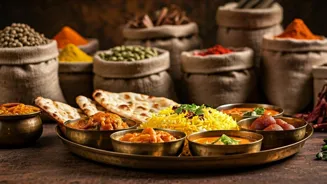Unveiling 8 Mind-Blowing Facts About Indian Cuisine! Discover the hidden depths of flavors, techniques, and history that redefine Indian food. Delve into the regional diversity, vegetarian roots, spice
mastery, lentil versatility, bread truths, and sweet temptations! Read on for a culinary adventure
Namaste, foodies! Get ready to have your kulchas dusted off your taste buds hit a flavour earthquake. We all think we know Indian food – butter chicken, biryani, maybe even a decent dosa. But trust us, there’s a lot more simmering beneath the surface than meets the eye (or palate!).
So, buckle up as we take you on a whirlwind tour of eight mind-blowing facts about Indian cuisine that will leave you saying, "Wah, bhai wah!" You'll never look at your thali the same way again. Get ready to have your perception of Indian food redefined!
This journey through the heart of Indian culinary heritage promises to surprise and delight, revealing the hidden depths of flavours, techniques and history embedded in every dish.
So, loosen your belts, sharpen your senses, and prepare to be amazed by the incredible diversity and richness that Indian food offers.
Exploring India's diverse regional cuisine beyond the stereotypes
First off, let's talk about the incredible regional diversity in Indian cuisine. Forget everything you think you know about "Indian" food, because what you get in a restaurant abroad is just the tip of the iceberg.
India has 28 states, and each one boasts its own unique culinary traditions, ingredients, and cooking styles. Imagine the difference between the fiery curries of Andhra Pradesh and the delicate coconut-based dishes of Kerala, or the hearty rotis of Punjab versus the steamed momos of Sikkim.
This is the true beauty of Indian food – an ever-evolving tapestry of flavors that reflects the country's diverse geography, culture, and history. Exploring this regional tapestry is like embarking on a culinary adventure that never ends, with each state offering a distinct flavour profile.
Indian vegetarian cuisine celebrates diverse plant-based dishes
Next up, did you know that vegetarianism has a deep and ancient roots in India? While many assume that Indian food is all about butter chicken and lamb biryani, vegetarian dishes actually make up a significant portion of the country's culinary landscape.
This is largely due to the influence of religions like Hinduism, Jainism, and Buddhism, which promote non-violence and respect for all living beings.
As a result, India has developed an incredibly diverse and innovative range of vegetarian dishes, from lentil-based dals and vegetable curries to paneer tikka and stuffed parathas.
Indian vegetarian cuisine isn't about limitations; it's about celebrating the abundance of plant-based ingredients and creating dishes that are both flavourful and nutritious. This rich tradition offers a stunning array of options for vegetarians worldwide.
Indian spices are diverse, offering flavor, aroma, color, and health benefits
Now, let's get spicy! But hold on, because there's more to Indian spices than just heat. While chilies are definitely a key ingredient in many Indian dishes, spices are actually used for a variety of purposes, including adding flavour, aroma, colour, and even medicinal benefits.
Think turmeric for its anti-inflammatory properties, ginger for digestion, and cardamom for its fragrant sweetness. Indian cooks are true spice masters, carefully blending and layering different spices to create complex flavour profiles that tantalize the taste buds.
Learning to appreciate the nuances of Indian spice blends is a journey in itself that enhances cooking experience. It's all about finding the right balance and understanding how each spice contributes to the overall flavour of the dish.
Lentils in Indian cuisine: versatile, nutritious, and diverse
Let's talk about the humble lentil. Dals, as they are known, are actually a staple food in India. We're talking about hundreds of different types of lentils, each with its own distinct flavour, texture, and cooking time.
From the creamy dals cooked on slow fire to the tangy dals tempered with mustard seeds and curry leaves, lentils are incredibly versatile and can be used in a wide range of dishes.
Not only are they packed with protein and fibre, but they're also incredibly affordable and easy to cook, making them a perfect choice for everyday meals. Don't think of dal as just a side dish; it's a culinary powerhouse that deserves to be the star of the show.
The variety of dals, ranging from toor dal to moong dal, offers a diverse palette for food lovers.
Roti, not naan, is the traditional Indian bread staple
Time to bust a popular myth about Indian bread! You may think naan is the go-to bread in India, but truth is, it’s more of a restaurant thing. In most Indian homes, you're more likely to find roti, also known as chapati, a simple unleavened flatbread made from whole wheat flour.
Roti is a staple food in many parts of India and is typically eaten with dal, vegetables, or curries. It's a healthier and more nutritious option than naan, which is often made with refined flour and butter. So next time you're craving Indian bread, why not give roti a try?
It is an amazing bread and is healthy as well. The simplicity of roti makes it a fantastic base for scooping up flavorful curries and vegetable dishes.
Exploring the diverse and enticing world of Indian sweets
Finally, let's get sweet! Indian sweets are a world unto themselves, with endless variety of desserts to tempt your taste buds.
From the syrupy jalebis to the creamy rice puddings, Indian sweets are often made with milk, sugar, and spices, and are enjoyed during festivals, celebrations, and special occasions.
Whether you have a sweet tooth or not, you won't be able to resist the allure of Indian sweets, which offer a perfect ending to any meal. The textures and flavors of Indian sweets can range from delicate and airy to rich and decadent.
Exploring the world of Indian sweets is like discovering a treasure trove of culinary delights, each one a unique expression of the country's rich cultural heritage.
AI Generated Content. Glance/InMobi shall have no liability for the content

